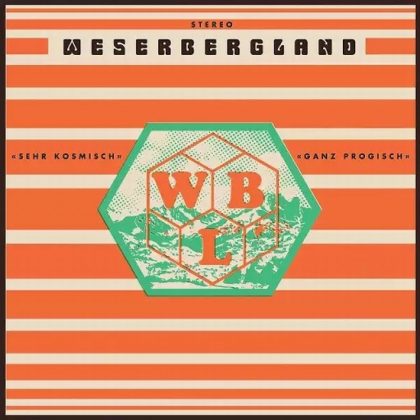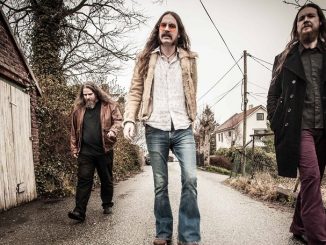[Apollon Records, 2017]

Intro: Vangelis Christodoulou
Translation: V. Christodoulou, D. Kaltsas
25 / 10 / 2017
“The Devil told you that! – the little man screamed, and he ran off full of anger and never returned”. Rumpelstiltskin is but one story among many others by the Brothers Grimm, that is said to be set in the Weser Uplands or Weserbergland, an outback in central Germany that adjoins Nordrhein-Westfalen, Hessia and Niedersachsen. Such is the scenery in the hills that inspired legendary icons Hans-Joachim Roedelius and Dieter Möbius of Cluster to set foot at the whistle-stop named Forst and redefine krautrock and electronic music. Between 1973-76, as long as their stay lasted, they would be sided by Michael Rother of NEU! to form Harmonia as well as none other than Brian Eno himself. Sehr Kosmisch, Ganz Progisch (german for “Very Cosmic, All Proggy”) is Ketil Vestrum Einarsen’s first attempt as a bandleader and his goal is to celebrate the music produced in the above-described setting and by a stretch, the space / kraut music of the 70s.
[bandcamp width=650 height=120 album=2652302586 size=large bgcol=ffffff linkcol=0687f5 tracklist=false artwork=small]
Die Kosmischen Kinder (The Cosmic Kids)
Ketil Vestrum Einarsen is already a prominent figure of the norwegian prog scene as a member of White Willow, Pixie Ninja (who have both put an album out this year) and Kaukasus, formerly a member in Jaga Jazzist and with appearances on Motorpsycho and Wobbler albums, among many others. Weserbergland however is distinctly all his. The renowned flutist is responsible for the general direction and the compositions of the album while performing an array of instruments. Together with swedish drummer Mattias Olsson (of Necromonkey and well… Änglagård as well as a bunch of collabs he’s had with Einarsen), Jacob Holm-Lupo (White Willow) and Gaute Storsve (Sleepyard) interchangeably on guitars and bass, they comprise the main core of the band. Several guests add to the mix, such as Einar Baldursson of the swedes Gösta Berlings Saga or Erik Johannessen and Lars Horntveth, both of Jaga Jazzist, who help create an album that can be enjoyed in the background and into the limelight.
Four lengthy selections ranging from 9 to 16 minutes are on the menu and they all seemingly pay homage to famous figures that have one way or another found themselves hanging around the Weser river, somehow (and semi-speculatively). Τhe opener, Tanzen und Springen is a title taken by a madrigal attributed to Hans Leo Hassler. It is necessarily a poppy cut with repetitive drums and whopping synth bass to give it an edge. A winner. Next comes Gustav Mahler’s Das Trinklied vom Jammer der Erde – yes, all the tracks are named after famous compositions, although they are nothing but namely homages. This is by far the proggiest track on the record, showcasing new-age aesthetics upon ambient and symphonic themes and loud rocky drums while the lads are not afraid of getting noisy. Bach’s Kunst der Fuge is not exactly a fugue, but I would think it attempts in a mechanistisch contrapuntal fashion and it gets extra naughty at it’s 3rd part. Tristrant’s four movements are paying tribute to 12th century german poet Eilhart von Oberg and his oldest surviving version of Tristan and Iseult. Keeping up with their motorik feeling and never losing experimentation points, the closing track is wild and uncompromising. Heavily processed new-age textures give way to the ending jazzy battle featuring a flute, a clarinet and a saxophone. The ideal bookend.
Sehr Kosmisch… is not a krautrock album, although krautrock is the starting point here: the repetitive dreamy sequences and the lush orchestration layers are present. It may derive influence from Harmonia (incl. the Harmonia ‘76 recordings with Eno) and perhaps from Cluster’s Sowiesoso album but it is certainly not a retro album. Compared to the aforementioned mentions, it lacks their bizarre, loose experimentation and the through-uncharted-territories attitude but it also sports an avant-poppier sensibility, akin to that taught by NEU! or Kraftwerk. But even that, the motorik approach is being deconstructed, dismantled and offered as a discontinuous dish in a rather structured cosmic kitchen. The result, thus, may be not be something entirely new but it is nevertheless served as new. From one end to another, I would suggest that Sehr Kosmisch… is your non-typical progressive rock album with pop tendencies that can be psychedelically symphonic while retaining its kraut references. Recommended to the kraut-heads and prog-heads alike.
8 / 10
Vangelis Christodoulou
2nd opinion
Assuming that the band of Ketil Vestrum Einarsen with Jacob Holm-Lupo, Mattias Olsson, Gaute Storsve and many glamorous guests falls into the category of supergroups, then it is a rare exception. Their debut is based on krautrock rhythm and abstraction, but also on the modern prog / post-rock, with intense experimental character, pop dynamics and an aura of an undeniable freshness, with literally everyone contributing to it. Olsson with his personal motorik playing, Lupo and Storsve with their intelligent basslines and the definite mvp, Einarsen, plays, samples and programs amazingly. The four compositions are a destination of frequent future visits with memorable ‘sights’, such as the notes of Einar Baldursson (Gösta Berlings Saga), Brynjar Dambo (White Willow), Stephen Bennett (Henry Fool), Lars Fredrik Frøislie (Wobbler), Lars Horntveth and Erik Johannessen (Jaga Jazzist), and Storsve’s guitar playing, which probably surprised me most of all.
8 / 10
Dimitris Kaltsas
[Apollon Records, 2017]

Εισαγωγή: Βαγγέλης Χριστοδούλου
Μετάφραση: Β. Χριστοδούλου, Δ. Καλτσάς
25 / 10 / 2017
«Ο Διάβολος στο είπε! – φώναξε ο ανθρωπάκος και έφυγε γεμάτος θυμό και δεν ξαναγύρισε ποτέ πια». Ο Κουτσοκαλιγέρης είναι μόνο μία από τις πολλές ιστορίες των Αδερφών Γκριμ, που λέγεται ότι διαδραματίζονται στο Weserbergland, μία περιοχή που ενώνει τη Βόρεια Ρηνανία-Βεστφαλία με την Έσση και την Κάτω Σαξονία. Τέτοια είναι η ομορφιά των εκεί λόφων που ώθησε τους μυθικούς Hans-Joachim Roedelius και Dieter Möbius των Cluster να εγκατασταθούν στην περιοχή Forst και να επαναπροσδιορίσουν το kraut και την ηλεκτρονική μουσική. Μεταξύ 1973-76, όσο και κράτησε η διαμονή τους, θα πλαισιώνονταν από τον Michael Rother των NEU! και άλλον κανέναν από τον ίδιο τον Brian Eno. Το Sehr Kosmisch, Ganz Progisch (Πολύ Συμπαντικά, Καθ’όλα Προοδευτικά) είναι η πρώτη προσπάθεια του Ketil Vestrum Einarsen ως ηγέτη και ο στόχος του είναι να γλεντήσει τη μουσική που παράχθηκε από τους παραπάνω και κατά μία έννοια, τη διαστημική / kraut μουσική των 70s εν γένει.
[bandcamp width=650 height=120 album=2652302586 size=large bgcol=ffffff linkcol=0687f5 tracklist=false artwork=small]
Die Kosmischen Kinder (Τα Κοσμικά Παιδιά)
Ο Ketil Vestrum Einarsen είναι ήδη μία εξέχουσα μορφή της νορβηγικής prog σκηνής, ως μέλος των White Willow, Pixie Ninja (και οι δύο κυκλοφόρησαν άλμπουμ φέτος) και των Kaukasus, επίσης σαν πρώην μέλος των Jaga Jazzist και με συμμετοχές σε άλμπουμ καλλιτεχνών όπως οι Motorpsycho και οι Wobbler, μεταξύ πολλών άλλων. Οι Weserbergland όμως είναι αποκλειστικά δικοί του. Ο διάσημος φλαουτίστας είναι υπεύθυνος για τη γενική κατεύθυνση όσο και για τις συνθέσεις, ενώ συμμετέχει παίζοντας πολλά και διάφορα όργανα. Μαζί με τον Σουηδό ντράμερ Mattias Olsson (των Necromonkey αλλά και των… Änglagård παλιότερα φυσικά, καθώς και ενός πλήθους συνεργασιών που έχει με τον Einarsen) και τους Jacob Holm-Lupo (White Willow) και Gaute Storsve (Sleepyard) εναλλάξ στις κιθάρες και το μπάσο, αποτελούν τον κύριο πυρήνα της μπάντας. Αρκετοί καλεσμένοι επιστρατεύονται, όπως ο Einar Baldursson των Σουηδών Gösta Berlings Saga ή ο Erik Johannessen και ο Lars Horntveth, αμφότεροι των Jaga Jazzist, οι οποίοι βοηθούν στη δημιουργία ενός άλμπουμ που μπορεί να εκτιμηθεί τόσο ακούγοντάς το στο παρασκήνιο όσο και έπειτα από ενδελεχή ανάλυση.
Το μενού περιλαμβάνει τέσσερις μακροσκελείς συνθέσεις μεταξύ 9 και 16 λεπτών και όλες φαίνεται να αποτίουν φόρο τιμής σε διάσημες προσωπικότητες οι οποίες με τον έναν ή τον άλλον τρόπο δραστηριοποιήθηκαν (ημι-υποθετικά) κάποια στιγμή γύρω από το ποτάμι Weser. Το εναρκτήριο κομμάτι, Tanzen und Springen, είναι ένας τίτλος παραδοσιακού κομματιού που αποδόθηκε στον Hans Leo Hassler. Κατά βάση πρόκειται για ένα ποπ κομμάτι με επαναλαμβανόμενα τύμπανα και ένα θηριώδες synth bass που του δίνει πυγμή. Με νίκησε με την πρώτη. Το επόμενο είναι το Das Trinklied vom Jammer der Erde του Gustav Mahler – ναι, όλα τα κομμάτια έχουν πάρει το όνομά τους από διάσημα έργα, αλλά δεν είναι τίποτε άλλο πέρα από φόροι τιμής κατ’ όνομα μόνο. Αυτό είναι το πιο προοδευτικό του δίσκου, και επιδεικνύει new-age αισθητική πάνω σε ambient και συμφωνικά θέματα και δυνατά τύμπανα, ενώ τα παιδιά δεν φοβούνται να γίνουν φασαριόζοι. Το Kunst der Fuge του Bach δεν είναι ακριβώς φούγκα, αλλά παρόλα αυτά επιχειρεί με μηχανιστική αντιστικτική διάθεση και καταλήγει να γίνεται ιδιαίτερα τολμηρό στο τρίτο μέρος. Τα τέσσερα μέρη του Tristrant είναι αφιερωμένα στον Eilhart von Oberg, ένα γερμανό ποιητή του 12ου αιώνα, και την πιο παλιά διασωζόμενη έκδοση του έργου Τριστάνος και Ιζόλδη. Συνεχίζοντας με motorik διάθεση και χωρίς να χάνουν σε πειραματισμό, το κλείσιμο του άλμπουμ είναι άγριο και απροσάρμοστο. Πολυεπεξεργασμένες new-age κυματομορφές ανοίγουν το δρόμο για την τελευταία -και λίγο τζαζ- μάχη μεταξύ ενός φλάουτου, ενός κλαρινέτου και ενός σαξοφώνου. Τέλειο κλείσιμο.
Το Sehr Kosmisch… δεν είναι ένας kraut δίσκος, αν και το kraut είναι η αφετηρία εδώ: οι επαναλαμβανόμενες ονειρικές συχνότητες και οι πλούσιες ενορχηστρικές διαβαθμίσεις είναι παρούσες. Ίσως να αντλεί επιρροή από τους Harmonia (συμπεριλαμβανόμενης της ηχογράφησης με τον Eno το 1976) και από το άλμπουμ Sowiesoso των Cluster, αλλά σίγουρα δεν είναι ρετρό. Σε σύγκριση με τα παραπάνω, δεν διαθέτει τον άκρατο πειραματισμό τους ούτε τον μεταξύ-αχαρτογράφητων-περιοχών τσαμπουκά τους, αλλά μας δείχνει μία πιο ποπ προσέγγιση, κάποιες φορές όμοια με αυτή των NEU! ή των Kraftwerk. Αλλά και σε αυτή την περίπτωση, το motorik στοιχείο αποσυντίθεται, εξαϋλώνεται και ξαναπροσφέρεται σαν ένα ασυνεχές πιάτο σε μία κατά τα άλλα δομημένη κοσμική κουζίνα. Το αποτέλεσμα λοιπόν δεν είναι κάτι εντελώς καινούριο, αλλά προσφέρεται σαν τέτοιο. Τελικά, θα έλεγα ότι το Sehr Kosmisch… είναι ένας μη τυπικός progressive rock δίσκος με ποπ ευαισθησίες, που μπορεί να γίνει ψυχεδελικά συμφωνικός ενώ διατηρεί τις kraut αναφορές του. Τον προτείνω φυσικά ανεπιφύλακτα τόσο στους κραουτάδες όσο και στους προγκρεσιβάδες.
8 / 10
Βαγγέλης Χριστοδούλου
2η γνώμη
Αν υποθέσουμε ότι το σχήμα του Ketil Vestrum Einarsen, με συνοδοιπόρους τους Jacob Holm-Lupo, Mattias Olsson, Gaute Storsve και αρκετούς ακόμα λαμπερούς καλεσμένους, εμπίπτει στην κατηγορία των supergroups, τότε αποτελεί μια σπάνια εξαίρεση. Το ντεμπούτο τους είναι βασισμένο στην krautrock ρυθμικότητα και αφαιρετικότητα, αλλά και στο σύγχρονο prog / post-rock, με έντονο πειραματικό και ηχοποιητικό χαρακτήρα, pop δυναμική και μια αύρα αναντίρρητης φρεσκάδας. Και συμβάλουν όλοι σε αυτό. Ο Olsson με το προσωπικό του motorik, ο Lupo και ο Storsve με τις ευφυείς τους μπασογραμές και κυρίως ο αδιαμφισβήτητος mvp, ο Einarsen, που παίζει, σαμπλάρει και προγραμματίζει εκπληκτικά. Οι τέσσερις συνθέσεις αποτελούν προορισμό συχνών μελλοντικών επισκέψεων με αξιομνημόνευτα αξιοθέατα, όπως το παίξιμο του Einar Baldursson (Gösta Berlings Saga), του Brynjar Dambo (White Willow), του Stephen Bennett (Henry Fool), του Lars Fredrik Frøislie (Wobbler), των Lars Horntveth και Erik Johannessen (Jaga Jazzist) και το κιθαριστικό παίξιμο του Storsve, που ίσως με εξέπληξε περισσότερο απ’ όλα.
8 / 10
Δημήτρης Καλτσάς





Κάντε το πρώτο σχόλιο